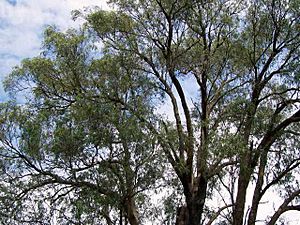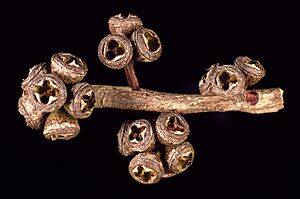Camden woollybutt facts for kids
Quick facts for kids Camden woollybutt |
|
|---|---|
 |
|
| Eucalyptus macarthurii at Bowral | |
| Conservation status | |
| Scientific classification | |
| Genus: |
Eucalyptus
|
| Species: |
macarthurii
|
The Camden woollybutt or Paddy's river box (scientific name: Eucalyptus macarthurii) is a special kind of tree. It is a medium-sized tree found only in a small part of New South Wales, Australia.
This tree has rough, stringy bark on its main trunk and bigger branches. Its smaller branches have smooth bark. It also has long, narrow adult leaves, white flowers, and small, bell-shaped fruits.
Contents
What the Camden Woollybutt Looks Like
The Camden woollybutt is a tree that usually grows up to 40 m (130 ft) tall. It has a special woody base called a lignotuber, which helps it regrow if it gets damaged.
Its bark is rough, greyish-brown, and stringy on the trunk and larger branches. The thinner branches have smooth, grey bark that peels off in short strips.
Leaves, Flowers, and Fruit
Young plants and new shoots have broad, egg-shaped leaves. These leaves are about 35–70 mm (1.4–2.8 in) long and 25–45 mm (0.98–1.77 in) wide. They grow in pairs directly opposite each other on the stem.
Adult leaves are shiny green on both sides. They are narrow and curved, measuring about 90–180 mm (3.5–7.1 in) long and 10–25 mm (0.39–0.98 in) wide. They have a stalk (called a petiole) that is 10–20 mm (0.39–0.79 in) long.
The flower buds grow in groups of seven. Each group is on a short stalk (a peduncle) about 4–10 mm (0.16–0.39 in) long. The individual buds are small, about 2.5–5 mm (0.098–0.197 in) long. They have a cone-shaped cap (an operculum) that is 2–3 mm (0.079–0.118 in) long.
The tree has white flowers. It usually flowers in January and May.
After flowering, it produces woody, cone-shaped or bell-shaped fruits. These fruits (called capsules) are about 2–5 mm (0.079–0.197 in) long and 4–6 mm (0.16–0.24 in) wide.
How it Got its Name
The Eucalyptus macarthurii was first officially described in 1899. This was done by two scientists, Henry Deane and Joseph Maiden. They wrote about it in a scientific paper.
The tree's scientific name, macarthurii, honors Sir William Macarthur. He was the first person to realize that this specific type of woollybutt was a unique tree.
Where the Camden Woollybutt Lives
The Camden woollybutt grows in open forests. You can find it on flat areas and near rivers or streams. It lives in the Central Tablelands and Southern Tablelands regions of New South Wales. This area is between the Blue Mountains and Goulburn.
Why it Needs Our Help
This special eucalypt tree is considered "endangered." This means it is at a high risk of disappearing forever. Both the Australian Government and the New South Wales Government have listed it as endangered.
The main reasons why this tree is in danger are:
- Habitat Loss: Its natural home is being cleared for other uses.
- Weed Invasion: Other plants (weeds) are growing where it lives and taking over.
- Grazing: Animals eating the young trees can prevent them from growing.
Past Uses of the Tree
In the past, people used to harvest this tree for a special substance. They would extract something called geranyl acetate from its bark. This was done using a process called distillation.
See also
 In Spanish: Eucalyptus macarthurii para niños
In Spanish: Eucalyptus macarthurii para niños




